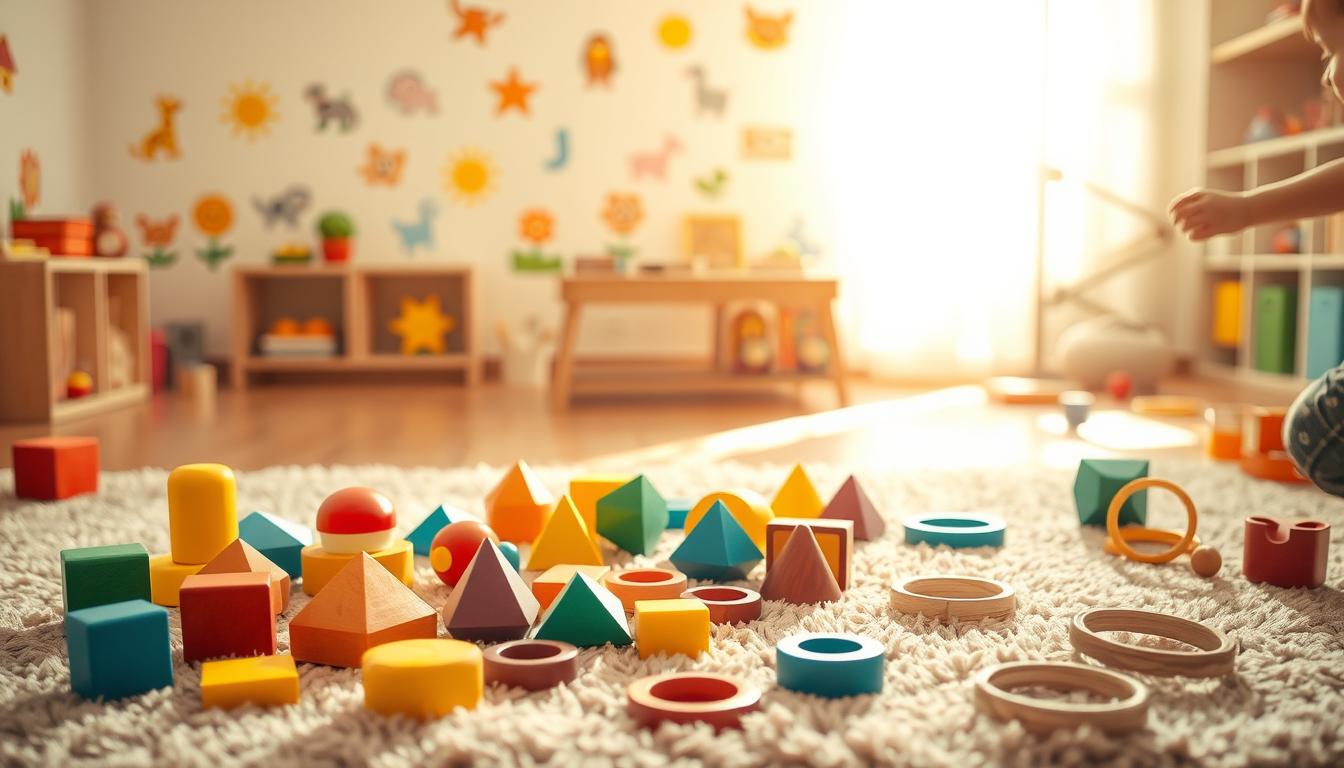Fun Shape Sorting Activities for Kids
“Play is the work of the child,” said Maria Montessori. This simple truth captures why interactive experiences matter so much in early development. Let’s explore how playful learning with geometric tools builds young minds.
These engaging exercises do more than entertain. They lay foundations for math skills, spatial awareness, and problem-solving. Children naturally gravitate toward matching colorful forms, turning abstract concepts into tangible discoveries.
Everyday moments become learning adventures. A toddler stacking blocks or a preschooler organizing puzzle pieces develops critical thinking through touch and experimentation. These activities adapt to different ages, keeping challenges fresh as skills grow.
Parents and educators will find endless ways to blend education with joy. From kitchen counter games to outdoor scavenger hunts, creative approaches make learning feel like pure play. Let’s unlock how these tools prepare kids for academic success while nurturing curiosity.
Key Takeaways
- Shape-based games build early math and reasoning skills
- Hands-on experiences enhance sensory development
- Activities adapt easily for different age groups
- Daily routines become teachable moments
- Interactive play supports kindergarten readiness
What Are Shape Sorting Activities and Why They Matter
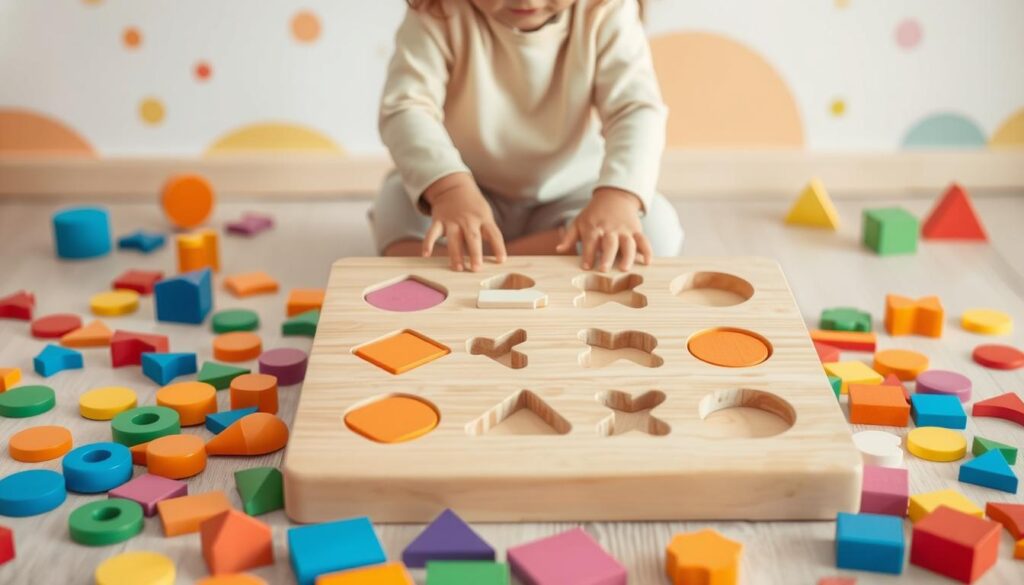
While matching socks seems simple, organizing geometric forms unlocks complex thinking in young minds. Matching involves pairing identical items—a foundational skill. Sorting requires deeper analysis, like grouping triangles by size or separating circles from squares. This distinction matters when selecting cognitive challenges suited to a child’s growing abilities.
Around age 2.5, children start recognizing patterns in their world. This natural curiosity makes it the perfect window to introduce structured tasks. “Sorting builds mental frameworks for math and science,” notes early education specialist Dr. Emily Torres. Kids learn to categorize objects by multiple traits—color, size, and form—all while strengthening memory and decision-making.
These exercises do more than teach geometry. They spark connections in growing brains, helping children process information faster. Executive function—the ability to plan and solve problems—gets a workout every time a toddler decides where to place a star-shaped block.
The benefits ripple outward. Pattern recognition from early skills practice later aids reading fluency. Logical thinking nurtured through playful challenges becomes the bedrock for algebra and coding. By turning daily moments into learning opportunities, caregivers equip kids with tools for lifelong development.
Simple Shape Sorting Activities for Preschoolers
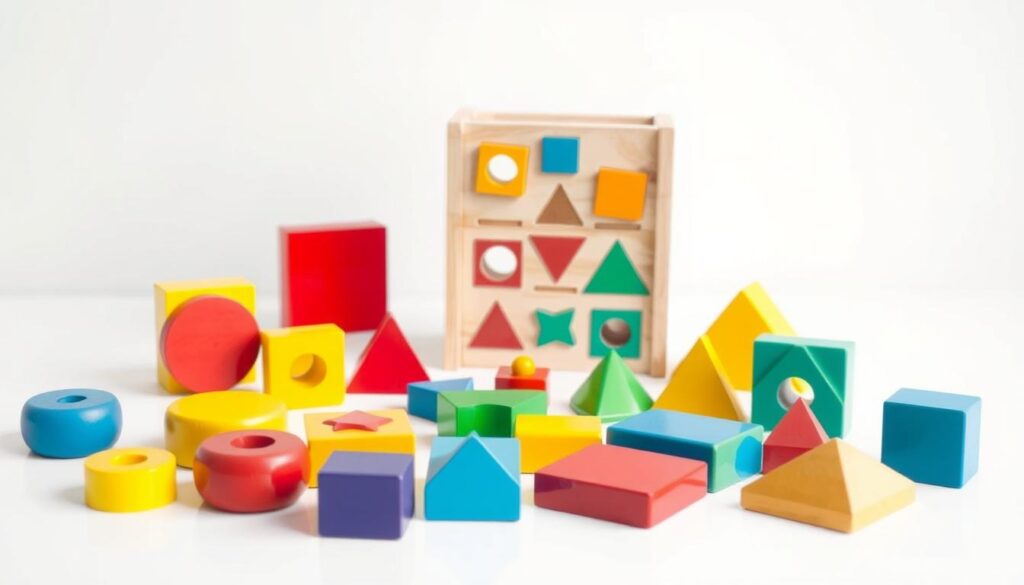
The journey from random exploration to purposeful organization marks a key milestone in early childhood. Structured play with geometric forms helps young learners bridge this gap naturally.
Classic Shape Sorter Toys
Timeless shape sorter toys offer more than colorful entertainment. Their durable design features a container with cutouts matching specific blocks, creating a satisfying “click” when pieces fit correctly. This immediate feedback loop reinforces pattern recognition while building finger strength.
Educators praise these tools for dual benefits: cognitive growth through matching challenges and physical development via precise hand movements. “The push-and-twist motion required for some sorter lids builds wrist flexibility crucial for writing,” explains occupational therapist Lisa Moreno.
Everyday Object Sorting
Transform household items into learning tools using two empty containers and differently shaped objects. Start with obvious contrasts—round bottle caps versus square building bricks. Demonstrate sorting one category first, then invite participation.
Mistakes become teachable moments. If a triangle ends up with circles, gently say “Let’s try this pointy piece again” while rotating it. Gradually introduce hexagons or stars as skills improve. This adaptable method works during snack time too—sorting circular crackers from rectangular cereal pieces makes learning delicious.
Engaging Shape Sorting Games to Boost Cognitive Skills
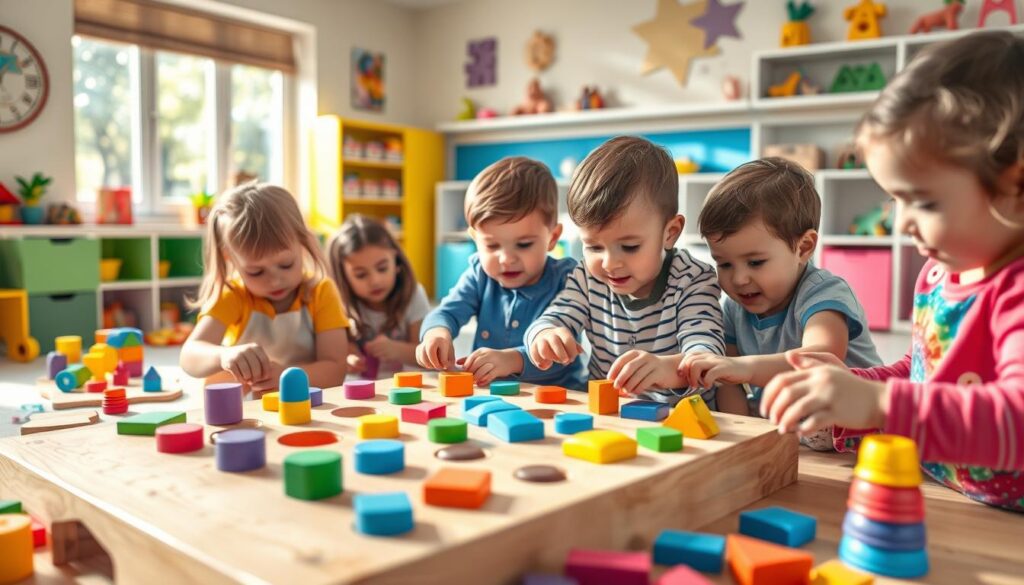
Young minds thrive when play meets purpose. Games that challenge children to analyze patterns build essential skills while keeping energy levels high. These experiences strengthen executive function—the mental processes behind planning and making decisions.
Leveling Up With Complex Forms
Introducing stars and pentagons takes matching games to new heights. “Irregular forms push kids to notice subtle differences,” says child development researcher Dr. Karen Lee. This sharpens visual discrimination—the ability to spot details that define each category.
Try two-step challenges. Ask children to sort red circles into one bin and blue squares into another. This dual-attribute task builds flexible thinking. Watch as they pause, compare, and choose—practicing logic that supports math readiness.
Learning in Daily Moments
Real life offers endless practice zones. Turn toy cleanup into a classification race—cars with wheels vs. blocks with edges. Fold laundry together, pairing socks by size while naming their shapes.
Kitchen tasks become skill builders. Let little hands organize spoons by size or group round fruits in a bowl. These real life connections show how categorization solves everyday problems. Children discover their growing skills have practical superpowers.
How to Choose the Right Shapes for Sorting Activities
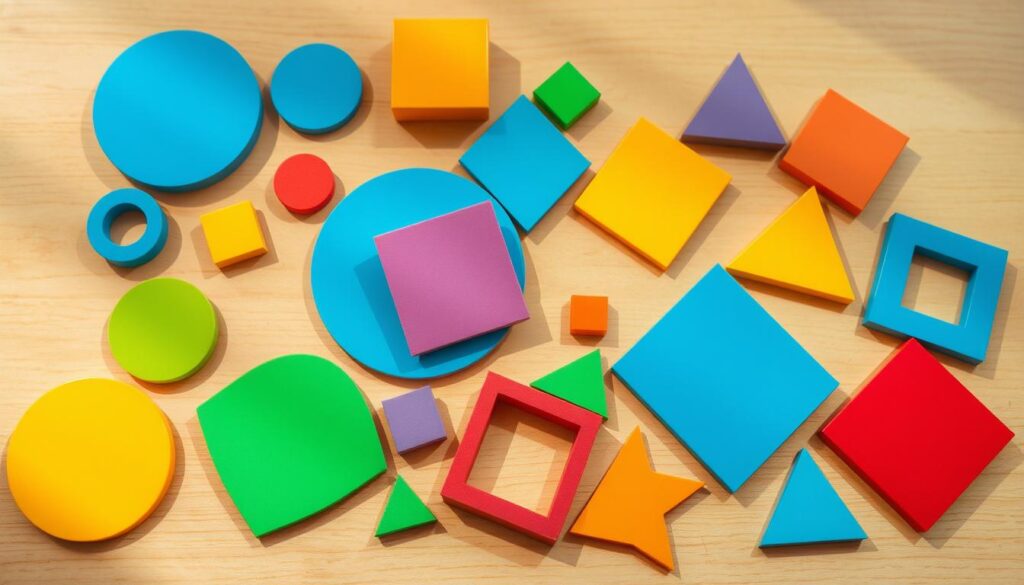
The art of selecting geometric tools transforms learning moments into building blocks for growth. Start with two contrasting shapes like circles and squares around age 2.5. These simple forms help young minds grasp basic differences—curved edges versus straight sides—while building confidence through achievable challenges.
Gradually introduce triangles and rectangles as skills develop. “Three-year-olds thrive when new forms connect to their environment,” observes child development expert Mia Chen. Consider roof peaks (triangles) or door frames (rectangles) to make abstract concepts feel familiar. This way of linking play to daily life deepens engagement.
Color adds another layer of learning. Ask your child to place yellow circles in one bin and blue squares in another. This dual-task approach strengthens cognitive flexibility—a critical skill for math readiness. Keep differences distinct at first; avoid pairing similar hues like teal and navy.
Progress to complex forms like pentagons once basic mastery occurs. Always present new shapes alongside known ones, creating bridges between existing knowledge and fresh discoveries. This age-sensitive way ensures challenges grow with your learner’s abilities, turning every success into stepping stones for future growth.
Innovative Ways to Integrate Sorting and Matching Skills
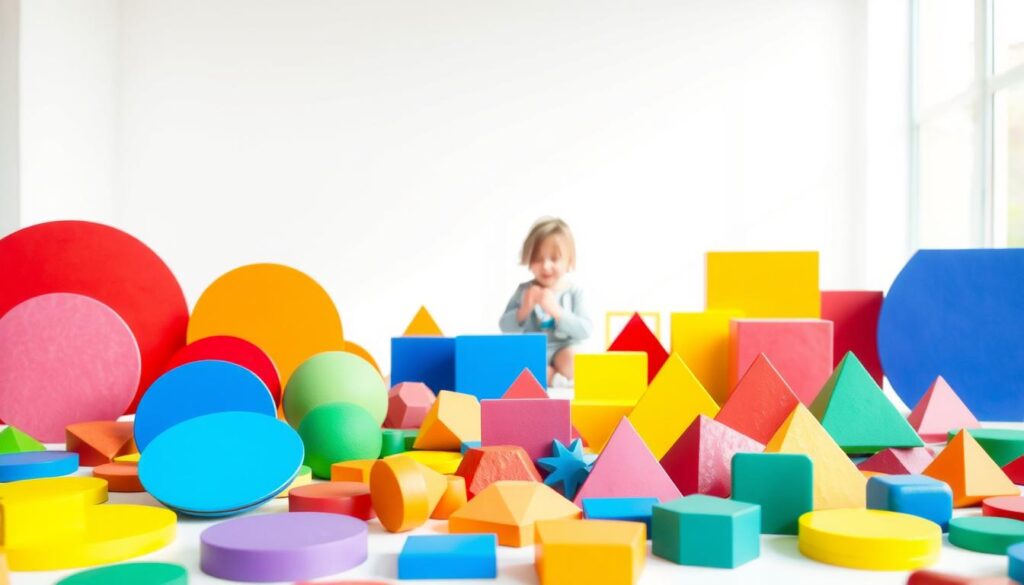
Household spaces become unexpected classrooms when you blend color and form recognition. Everyday items like toys, kitchen tools, and clothing offer endless opportunities to refine skill development through creative challenges.
Combining Color and Shape
Double-category games boost brain flexibility. Ask children to collect all red circles from mixed items, then switch to finding blue triangles. This way of layering criteria strengthens decision-making muscles. “Multi-attribute sorting builds neural pathways for complex problem-solving,” explains educator Rachel Simmons.
| Activity Type | Focus Area | Key Benefit |
|---|---|---|
| Color-Only Sorting | Kitchen Items | Strengthens visual grouping |
| Shape + Color Challenges | Playroom Toys | Enhances multi-tasking |
| Scavenger Hunts | Entire Home | Boosts spatial awareness |
Introducing Advanced Shapes
Hexagons and octagons add exciting variety to matching games. Create treasure hunts where kids find stop-sign-shaped items (octagons) or beehive-inspired objects (hexagons). These ways of exploring less common forms prepare children for geometry concepts.
Turn cleanup time into a learning game. Challenge them to organize bedroom areas by both color and form—yellow stars in the toy chest, green rectangles in the art bin. This practical approach shows how classification solves real-world problems.
List of Fun Shape Sorting Activities
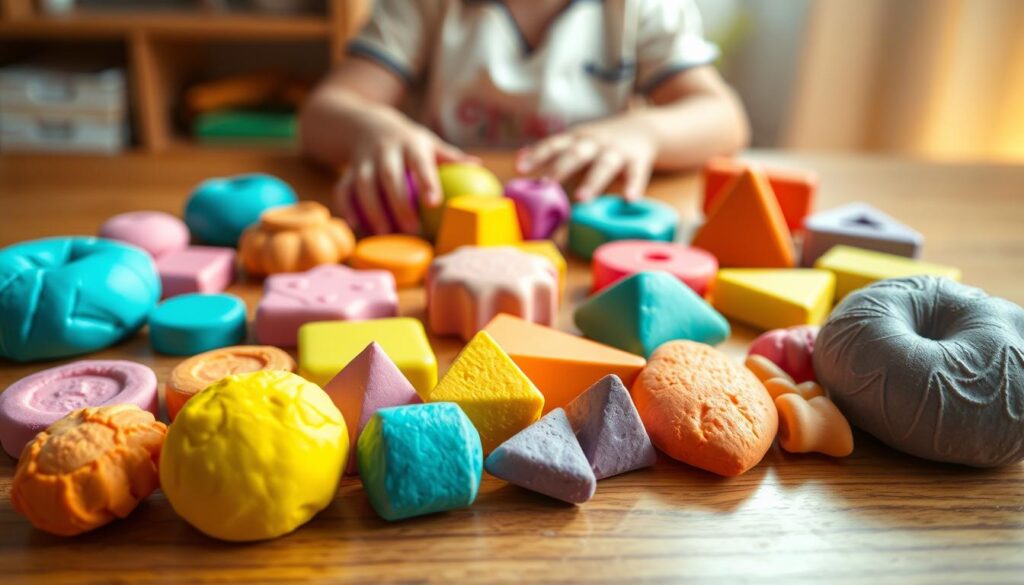
Learning through movement and creativity sparks lasting connections in young minds. These hands-on experiences turn abstract concepts into adventures that feel like pure play. Let’s explore dynamic methods that blend physical engagement with cognitive growth.
Interactive Puzzle and Play Dough Matching
Puzzles with uniquely shaped pieces turn problem-solving into joyful discovery. Children feel triumphant when fitting a star into its matching slot—a win that builds spatial awareness. “Manipulating 3D forms prepares fingers for writing while training eyes to spot patterns,” shares kindergarten teacher Sarah Wilkins.
Play dough takes this activity to new creative heights. Kids roll and press clay into circles or triangles, then match their creations to outline cards. This tactile process strengthens fine motor control and color recognition simultaneously.
Shape Hopscotch and Scavenger Hunts
Transform your backyard into a learning zone with chalk-drawn hexagons and squares. Call out forms like “Jump to the rectangle!” to combine physical exercise with quick thinking. This energetic play style helps restless learners absorb concepts through motion.
Scavenger hunts turn any environment into an exploration zone. Hide oval rocks or rectangular blocks around the house, then watch young detectives connect geometric ideas to their world. For advanced challenges, ask them to find two attributes—like “something blue and circular.”
These dynamic activities prove education thrives beyond worksheets. Whether molding clay masterpieces or racing to find hidden forms, children gain real-world skills through experiences that feel anything but ordinary.
The Role of Shape Sorting Activities in Early Development
Every twist of a puzzle piece and snap of a block builds more than just towers—it constructs neural pathways. These playful interactions strengthen multiple areas of growth simultaneously, creating a way for children to explore their world while developing essential skills.
Building Dexterity Through Play
Small hands gain big abilities when maneuvering geometric pieces. The pincer grip used to pick up a star-shaped block directly prepares fingers for holding pencils. “Precision movements during matching games build hand muscles and coordination,” explains occupational therapist Mara Simmons.
Math Foundations Take Root
Classifying circles and squares teaches more than geometry. Children discover patterns and relationships—core concepts for algebra. When a child sorts triangles by size, they’re practicing measurement skills without numbers.
| Skill Area | Activity Example | Developmental Benefit |
|---|---|---|
| Fine Motor | Placing hexagons in slots | Improves pencil grip readiness |
| Math/Logic | Grouping objects by two traits | Strengthens pattern recognition |
| Language | Describing texture and edges | Expands descriptive vocabulary |
Verbal interactions during playtime boost language growth. Naming forms like “oval” or “diamond” while sorting helps children connect words to visual concepts. This way of learning through dialogue builds communication skills that support classroom success.
These experiences create mental frameworks for complex thinking. When a preschooler realizes stop signs match the octagon in their toy bin, they’re forging connections that fuel creative problem-solving—a crucial skill for lifelong learning.
Tips for Parents and Educators to Maximize Learning
Effective teaching strategies turn everyday interactions into growth opportunities. Thoughtful setups and responsive guidance help children build confidence while exploring new concepts.
Creating an Enriched Environment
Design spaces that invite discovery. Use low shelves with clearly labeled bins for materials—this system helps young learners find tools independently. Natural lighting and cozy seating create a calm environment for focused play.
When mistakes happen, turn them into teachable moments. Gently say “This octagon wants to be with its friends!” while moving misplaced items. This approach reinforces language skills without discouraging effort.
Guidelines for Different Age Groups
Match challenges to developmental stages. Start with circle/square sorting for 2-year-olds. By age 4, introduce multi-step tasks like organizing buttons by color and form simultaneously.
| Age Range | Activity Type | Skill Focus |
|---|---|---|
| 2-3 years | Basic two-form matching | Object identification |
| 3-4 years | Color + shape sorting | Multi-attribute thinking |
| 4-5 years | Advanced category systems | Logical reasoning |
Use descriptive language during play. Ask “Why does this piece belong here?” to encourage verbal reasoning. Celebrate progress with specific praise like “You matched all the triangles!” This system of feedback keeps learning joyful and effective.
Conclusion
Foundational learning tools often hide in plain sight. Shape sorting activities stand out as powerful allies in early education, blending playful discovery with skill-building moments. These experiences turn kitchen counters into math labs and toy bins into logic workshops.
Children thrive when challenges meet creativity. Through matching games and classification tasks, they build cognitive flexibility alongside motor skills. A toddler organizing blocks by color or a preschooler grouping leaves by form demonstrates problem-solving in action.
The magic lies in adaptability. Caregivers can modify challenges using everyday items—from socks to snack crackers. This system grows with the child, offering fresh puzzles as abilities advance.
By weaving these exercises into daily routines, adults create rich learning environments. Whether through structured preschool tools or impromptu scavenger hunts, shape sorting activities prove education isn’t confined to classrooms. They prepare young minds to decode patterns, make matching connections, and navigate our geometric world with confidence.
FAQ
Why are shape-based activities important for early learning?
What age is best to start introducing sorting tasks?
How do these games support cognitive growth?
Can I use household items instead of buying toys?
How can I combine color and shape challenges?
What shapes should beginners start with?
How do scavenger hunts tie into skill-building?
Can these activities prepare kids for math?
What’s a simple way to enrich the learning environment?

Sharon Molly is a content creator in lifestyle, fashion, and travel, delivering style-savvy advice and destination insights to inspire confident living. With a background in digital media, she combines aesthetics with practical guidance for modern women on the go.

